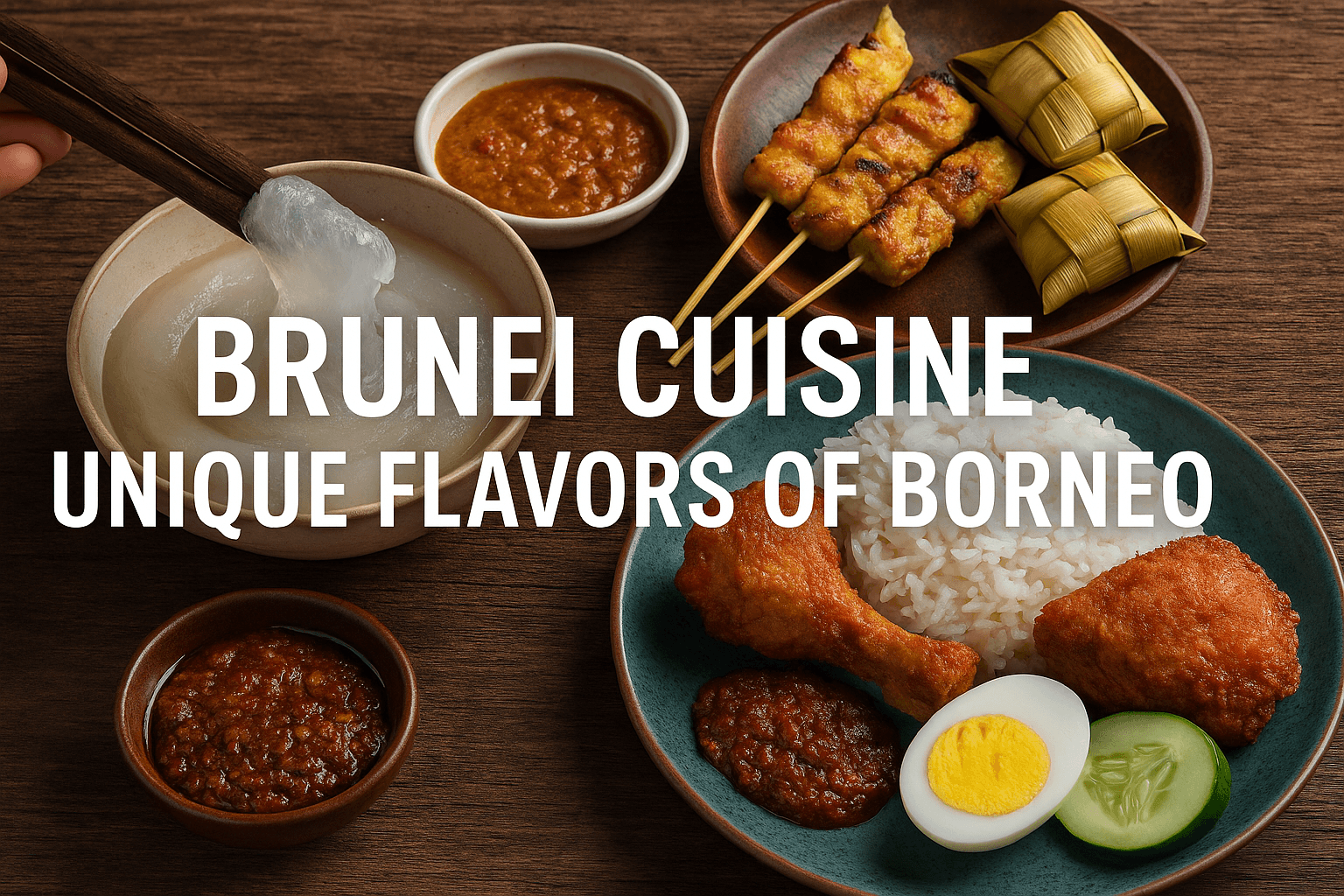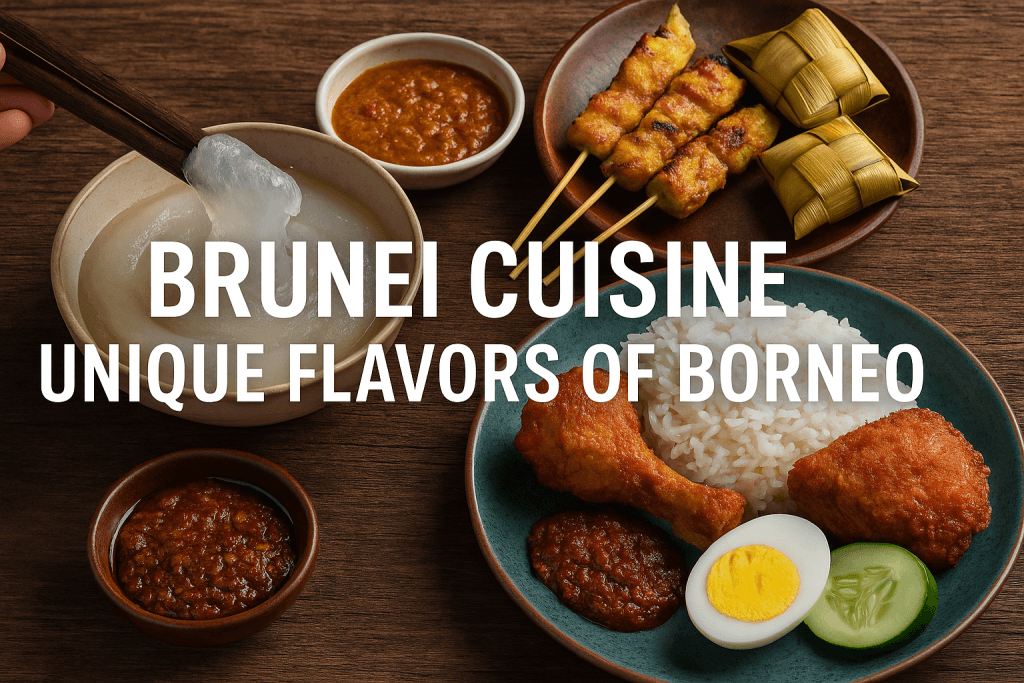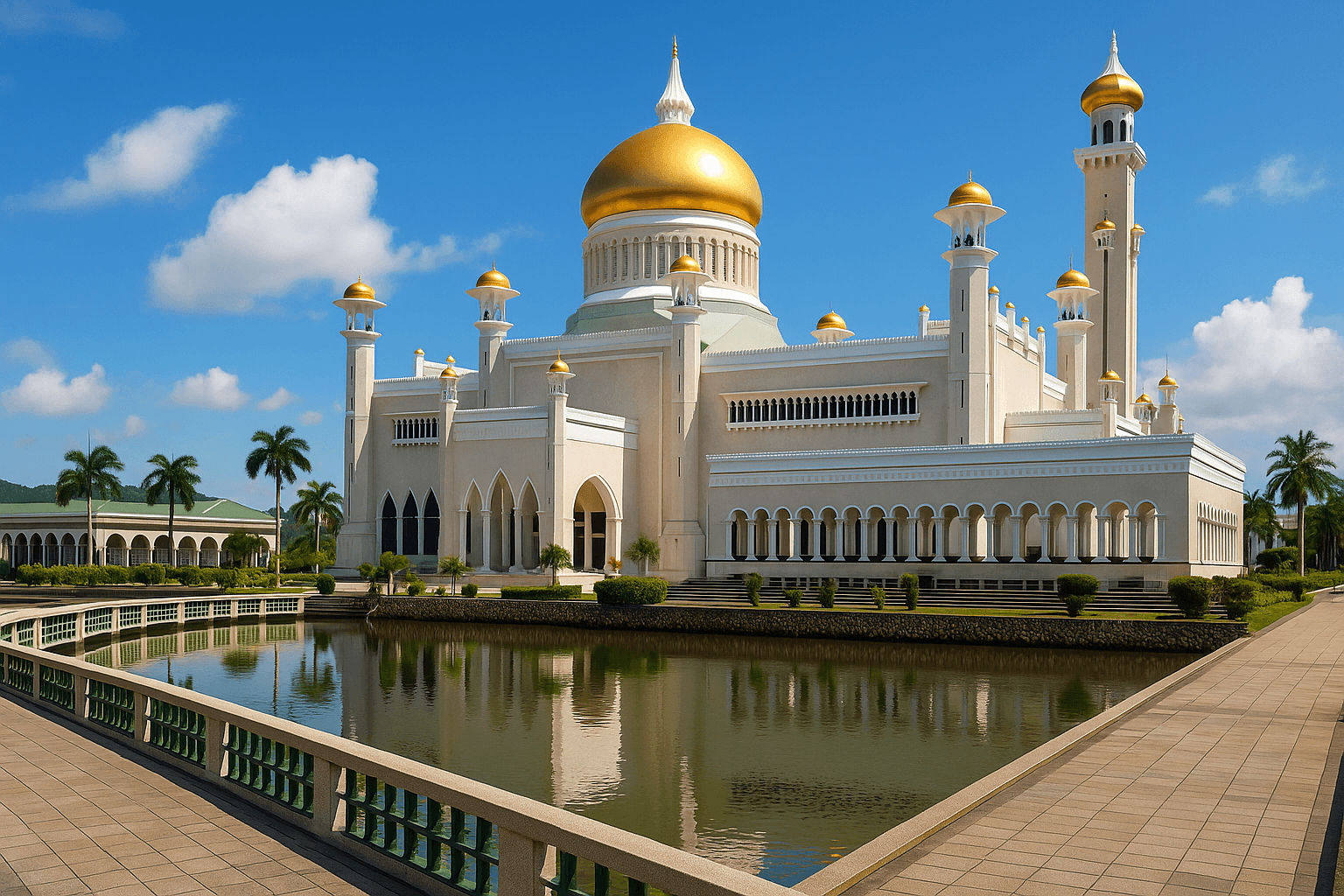Brunei Cuisine Unique Flavors of Borneo reflects the deep cultural tapestry of this small yet fascinating nation. Nestled on the northern coast of Borneo, Brunei draws influences from its Malay roots, Islamic traditions, coastal geography, and centuries of trade with neighboring regions. The result is a culinary identity that is vibrant, aromatic, and distinct.
Traditional dishes highlight the abundance of rice, sago, seafood, and tropical fruits, while modern interpretations fuse international flavors with local authenticity. Exploring the cuisine of Brunei provides insight not only into food but also into the values of community, hospitality, and cultural pride.

Historical Roots of Brunei Food Culture
The foundations of Brunei Cuisine: Unique Flavors of Borneo trace back centuries. The Malay people, indigenous to Borneo, cultivated rice and sago while relying heavily on fishing. Over time, trade routes introduced Indian spices, Chinese noodles, and Arab cooking methods. Brunei’s Islamic identity also shaped dietary practices, ensuring that dishes remain halal and celebrations often revolve around shared meals. These layered influences created a cuisine that is simultaneously local and global.
Key features of Brunei food history include:
Heavy use of coconut milk in curries and desserts
Influence of Chinese stir-frying and noodles
Aromatic spices introduced by Indian traders
Adoption of Middle Eastern grilling styles
Indigenous staples like sago forming the base of national dishes
Core Ingredients in Brunei Cooking
A closer look at ingredients helps us understand why Brunei Cuisine: Unique Flavors of Borneo stands apart.
Rice and Sago – While rice is the everyday staple, sago starch remains central, especially in the iconic dish Ambuyat.
Seafood – With long coastlines and rivers, fish, prawns, and squid are ubiquitous.
Spices and Herbs – Lemongrass, turmeric, ginger, galangal, and chilies provide layers of aroma and heat.
Coconut – Coconut milk and grated coconut enrich curries, rice dishes, and sweets.
Tropical Fruits – Durian, rambutan, bananas, and pineapples appear in both savory and sweet recipes.
Signature Dishes of Brunei
Ambuyat: The National Dish
Ambuyat epitomizes Brunei Cuisine: Unique Flavors of Borneo. Made from sago starch cooked into a sticky, glue-like texture, it is eaten with bamboo sticks called chandas. Diners dip the starchy mass into sour and spicy sauces such as cacah binjai. The communal nature of eating Ambuyat reflects Bruneian values of family and unity.
Nasi Katok
Nasi Katok is simple yet beloved. It consists of plain rice, crispy fried chicken, and sambal chili paste. Its affordability and availability made it a national street food icon, widely consumed by locals across all walks of life.
Satay
Satay skewers, marinated in turmeric and spices, are grilled to smoky perfection and served with peanut sauce. While satay is popular across Southeast Asia, Brunei’s version emphasizes sweetness balanced with mild heat.
Kelupis
Kelupis are glutinous rice rolls wrapped in banana leaves. Often served at festivals, they highlight the significance of rice in ceremonial and everyday life.
Beef Rendang
Although associated with Indonesia, rendang in Brunei has its own character, featuring richer coconut milk and slightly sweeter spices.
Everyday Meals in Brunei
For most families, Brunei Cuisine: Unique Flavors of Borneo is experienced through daily meals at home. Breakfast may include fried noodles, roti with curry, or nasi lemak. Lunch centers around rice with fish curry or grilled chicken. Dinner is often lighter, featuring soups, vegetable stir-fries, and sambal dips. The presence of communal dining emphasizes togetherness.
Brunei Snacks and Street Food
Street food culture is vital in understanding Brunei Cuisine: Unique Flavors of Borneo. Popular snacks include:
Kueh – Colorful steamed cakes made from rice flour and coconut.
Pisang Goreng – Fried bananas, a favorite afternoon treat.
Pulut Panggang – Glutinous rice grilled in banana leaves with spiced fillings.
Teh Tarik – Frothy pulled tea, enjoyed with snacks at night markets.
Beverages in Brunei
No discussion of Brunei Cuisine: Unique Flavors of Borneo is complete without beverages. Alongside teh tarik, air bandung (rose syrup with milk), kopi (local coffee), and herbal drinks are staples. During Ramadan, refreshing drinks like coconut water and lime juice accompany evening meals.
Religious and Cultural Influences
Islam plays a defining role in shaping Brunei Cuisine: Unique Flavors of Borneo. All dishes adhere to halal standards, and food preparation follows ethical guidelines. Major celebrations like Hari Raya Aidilfitri showcase lavish spreads of traditional dishes. Weddings and community events also emphasize sharing food as a sign of blessing.
Regional Flavors Across Brunei
Though small in size, Brunei offers regional variations:
Kampong Ayer (Water Village) highlights seafood soups and grilled fish.
Tutong District emphasizes rice cakes and durian-based condiments.
Belait District offers beef dishes with stronger seasonings.
Temburong District preserves indigenous jungle ingredients such as wild ferns and bamboo shoots.
These differences enrich Brunei Cuisine: Unique Flavors of Borneo, proving that even within a small nation, culinary diversity thrives.
Influence from Neighboring Countries
Brunei shares Borneo with Malaysia and Indonesia, and its proximity to the Philippines has left culinary imprints. Laksa noodles, ayam penyet, and halo-halo desserts all appear in Brunei menus. However, Brunei adapts these imports, ensuring they align with local tastes and Islamic guidelines.
Modern Developments in Brunei Food Culture
Globalization has brought new opportunities to Brunei Cuisine: Unique Flavors of Borneo. Urban centers now feature international restaurants, fusion cafes, and modern bakeries. Young chefs experiment with traditional recipes, presenting Ambuyat in gourmet forms or incorporating Bruneian spices into Western pastries. Food festivals and tourism initiatives also highlight Brunei’s gastronomy as a cultural asset.
Brunei Cuisine in Celebrations
Food takes center stage in Bruneian festivities:
Hari Raya Aidilfitri – Tables overflow with rendang, satay, kueh, and festive drinks.
Weddings – Large banquets symbolize prosperity and community.
National Events – Dishes like nasi katok and kelupis are served at public gatherings.
Health Aspects of Brunei Food
Traditional Brunei Cuisine: Unique Flavors of Borneo emphasizes natural, fresh ingredients. Herbs like turmeric and ginger have medicinal properties. Coconut provides healthy fats, while fish offers lean protein. Although modern diets pose challenges with sugar and fried foods, traditional cooking methods encourage balance and moderation.
Brunei Cuisine as Cultural Identity
Ultimately, Brunei Cuisine: Unique Flavors of Borneo is more than food; it is cultural identity expressed through flavor. It tells the story of trade, religion, family, and survival. Every dish carries symbolism, from the sticky unity of Ambuyat to the communal skewers of satay. Preserving culinary traditions ensures that younger generations remain connected to heritage.
Conclusion
Exploring Brunei Cuisine: Unique Flavors of Borneo is a journey into history, faith, and community spirit. From national dishes like Ambuyat and nasi katok to vibrant street food and festive spreads, Brunei’s culinary heritage is as unique as its people. It reflects the heart of Borneo, shaped by geography, culture, and centuries of tradition. For visitors and locals alike, the cuisine of Brunei is an invitation to savor identity, unity, and the distinctive flavors of this remarkable nation.


